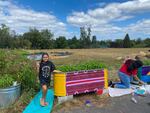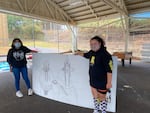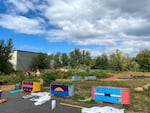Oregon school districts received millions of state and federal dollars to expand summer offerings for students, with the expectation that the programs might help students catch up, or reconnect to school after more than a year learning from bedrooms and dining rooms, rather than classrooms.
Districts had free rein to design programs that would best fit their students, or to expand existing programming to include more students.
Some recurring offerings, like credit recovery or Ninth Grade Counts, continued. But the funding also created an opportunity for districts to support outside organizations in what they provided in the summer. And unlike last year, low COVID-19 case rates eased restrictions in the weeks after school let out.
It may be difficult to tell if summer programs helped students “catch up” after COVID-19 until after the school year starts. Summer learning may also have been interrupted by the delta variant. But for some, this summer offered a return to a school or educational setting, or a chance for students to have fun and socialize with peers.
NAYA Camp Rise connects students with culture, each other
On a recent afternoon at NAYA, the Native American Youth and Family Center, 9-year-old Alyssa finished painting vibrant purples and yellows onto a stock tank, a large tub with plants growing out of it. Stock tanks border the community garden at NAYA.
“That is going to be the space where community comes together to cook our traditional foods,” said Mick Rose, NAYA’s education, culture and wellness manager.
Each painted tank is an interpretation of patterns from traditional basket designs. Alyssa helped pick the design and the colors for the tank.
“I felt proud of myself,” Alyssa said.

Alyssa, a Portland fourth grader, poses with a stock tank she painted this summer. She chose the design and colors.
Elizabeth Miller / OPB
Alyssa was just one of several students at NAYA’s Camp Rise, a program for students and their families throughout the summer. It was one of several hosted by culturally-specific organizations, like NAYA, with funding from PPS.
During the camp, students spent time painting, playing, or talking about topics like first foods or cultural medicine. Twice a week, students went home with bags of food from the garden. Alyssa says other than painting, she enjoyed Fridays, when they went hiking or swimming.
On Tuesdays, Thursdays, and weekends, NAYA provides activities for families, or camping spots at Oxbow Regional Park.
“All of these activities, they’re welcome to bring their parents and their siblings, so everything is intergenerational,” Rose said.
Eleven-year-old Dezeray came to NAYA this summer with her aunt. That’s how she met 17-year-old Breonna. The girls bonded over an art piece Breonna worked on this summer, a mural featuring three generations.
“It’s really fun to express how I am to them,” Dezeray said of Breonna and the other students at NAYA. “I’m normally a shy person, so I don’t make a lot of friends.”
At first, Breonna thought the camp would be virtual. But she was excited once she learned it was in-person. She also felt safe at NAYA.
“It’s helped me in a lot of ways,” she said. “I got to meet new people, I got to speak out, and I got to experience new parts of my art ability that I usually don’t show.”
This is Breonna’s largest art piece yet - the mural is so large, it takes two people to hold it up.
The camp allowed time for students to play and socialize, something students haven’t been able to do much since 2020.
“The first couple of days were a bit tentative, and then they’re just like excited, and they want to run around and play, and we let them,” Rose said. “We’re not going to just paint for six hours, we’re going to let them do what they want to do.”

Dezeray, left, and Breonna, right, hold up Breonna's unfinished mural. When complete, Breonna said the mural will show three generations: the elder, the young adult, and the child.
Elizabeth Miller / OPB
Rose recalled a moment this summer, where they had a chance to show a group of kids gardening in action. The students took down a tall, droopy sunflower and harvested the seeds.
“You get to have these experiences in the garden, you get to have these experiences in person,” Rose said. “Being able to do that in a safe way felt really special.”
For the young adults supervising the students, some of whom grew up going to NAYA, this summer proved a way to give back to the organization while also getting back out into the world.
Kobe Norcross is 20, a college student heading to Portland State University this fall.
“It was kind of a culture shock for me cause I was on lockdown pretty tough - I didn’t go out,” he said. “...it’s also really nice as well because all these youth have also been experiencing the same thing I have.”
But he also wanted to make sure students felt included, especially after more than a year of isolation.
“I didn’t want any of the kids to feel out of place in the community, because a lot of times when I was a kid, it was really hard for me to go out and talk to people,” he said. “I wanted to be kind of like that intermediary.”
Expanded summer programming not without problems
Throughout the pandemic, school districts have struggled with technological problems, changing state rules to deal with shifting health concerns, as well as tough decisions about new learning models. But over the last year, they have received millions of dollars in state and federal funding to help mitigate how the COVID-19 pandemic has affected students.
At Portland Public Schools, district officials sent out a request for proposals for summer programming partners in April, asking organizations to submit plans and budgets for programs with student safety as a priority.
Dani Ledezma, PPS’ senior advisor for racial equity and social justice, said preliminary numbers show about 9,000 PPS students participated in programs this summer, which is about 19% of the district’s student population. That number includes participants in the district’s own programs, including a Summer Acceleration Academy for students in elementary and middle school.
Ledezma said officials want to dig into attendance data, as well as more qualitative information, like what worked and what didn’t. But Ledezma said the district achieved one of its main goals, to prevent gun violence by offering a safe place for students.
“Certainly anecdotally in the spring, there was a lot of brazen daytime shootings that were very close to our schools, and impacted families,” Ledezma said. “We know this summer that gun violence still did impact our families, but in terms of that brazen, close to schools, we didn’t see that.”
But Ledezma said the district also found places to improve for next year.
“While we were successful to the over 9000 students that participated, I think that we have a lot of learning to do,” Ledezma said. She mentioned support for program partners and communication.
Some parents said communication was a main issue. They said the summer schedule arrived too late or was not shared widely enough. PPS’ summer program catalog wasn’t available until late June, even though some camps listed mid-June start dates.

This summer, Portland-area students painted the stock tanks that border NAYA's garden with patterns based on traditional Native American basket designs.
Elizabeth Miller / OPB
The district also had to make “adjustments” to some programs -- which meant canceling or moving the location of at least one program.
“Where there was lower enrollment, we tried to move everyone in a way so that we could kind of maximize the resources of both educators, administrators, and then also nutrition services and transportation,” Ledezma said.
For one family, their experience with a program did not go as planned.
Amy Geoffroy’s daughter Abigail was signed up for a Hampton Tutors leadership camp that started in early August.
The program was set to be at Grant High School, where the 17-year old is heading into her senior year. But then the program moved. And on that first day, Abigail was the only student that showed up.
“We decided to try again the second day, and she was again, the only person,” Geoffroy said.
Geoffroy said it was disappointing, especially the lost opportunity for her daughter, who experiences disabilities, to spend time with other students.
“Peer interaction, especially when you have a child with a disability, can be real challenging when school’s not in session, and so, it was disappointing in a lot of different regards,” Geoffroy said. “It put me as a working parent in another bind, trying to find something for her to do.”
Abigail did get to spend time this summer with friends, but August was open. She ended up going to another Portland Parks and Recreation camp for one of the three weeks of the leadership camp.
But Geoffroy was looking forward to take advantage of an opportunity to send Abigail to a camp at her school, and was disappointed that it didn’t work out.
“It just felt so, ‘let’s just throw a bunch of money at a bunch of different nonprofit partners, let’s not have the district share out what the information is, and let’s hope for some sort of impact’,” Geoffroy said.
Ledezma said over the summer programs, there were nine positive cases among students and 10 positive cases among staff.
As the summer ends and students return to school, there’s something different about this year that wasn’t here at the beginning of the summer: the delta variant.
School year concerns
Ledezma said the delta variant “probably” affected attendance and interest in the programs this summer, but health and safety protocols were implemented “with fidelity.”
The school year starts Wednesday for PPS students. With that, students will return to full-time in-person learning. Like the summer, students will be together in-person again, wearing masks. But unlike the summer, they’ll be indoors and back in large groups.
Dezeray, the 11-year-old at NAYA’s Camp Rise, isn’t ready to go back to school in-person. Neither is her friend Breonna, a senior at David Douglas High School.
“If I do virtual online school, it will be a lot easier for me and my family, so we don’t have to worry about getting COVID,” Breonna said. “It’ll be a lot safer.”
Nine-year-old Alyssa, who is heading into 4th grade at Faubion K-8 in Portland, is going back in-person.
So is 17-year-old Abigail. Her mother Amy Geoffroy said being back with the teachers who know her, and her peers is important.
But with the delta variant, Geoffroy is worried about how long Abigail and her classmates will be in school before someone is exposed to COVID-19. Abigail is also immunocompromised and has received a third vaccine dose. Geoffroy said it’s a challenge choosing between two imperfect options.
“There’s so much to consider, and it’s not just, ‘hey, do you want this online thing that will protect your kids’ health’…” Geoffroy said. “At the end of the day I also want her learning and I want her engaged with her peers.”



